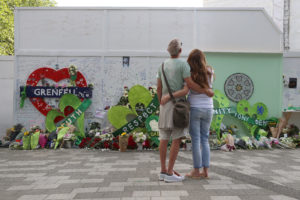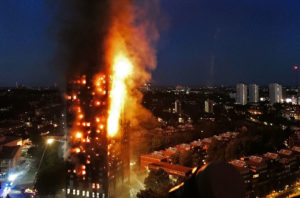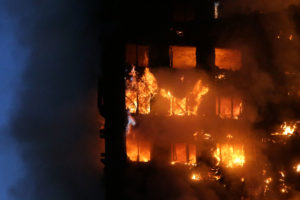At 12.54am on the 14 June 2017, a small fire started in a fridge on the fourth floor of a west London tower block. It quickly spread from the window of the kitchen in which it started, and ignited the plastic cladding system which had recently been installed on the tower.
Over the next seven hours, the blaze would engulf the entire building, smoke would spread rapidly through its interior and the firefighting operation — despite many instances of individual bravery — would fail to reach many of those who were told by call operators to stay put and wait for help.
By morning, 70 of the 293 people who were in the tower when the blaze broke out would be dead. Two more would follow: an unborn baby named Logan Gomes and 74-year-old Maria ‘Pily’ Burton.
Five and a half years on, and the public inquiry into the Grenfell Tower blaze has finally completed its hearings, with closing statements last week. The counsel, Richard Millett KC, summed up by saying one simple conclusion could be definitively made from the evidence: that every single death at Grenfell was avoidable. “There was nothing”, he said, “unknown or not reasonably knowable which caused or contributed to the fire and its consequences.”
“On the contrary, each and every one of the risks which eventuated at Grenfell Tower on that night were well known by many and ought to have been known by all who had any part to play.” The question of how blame should be shared, though, is far less simple.
Each corporate and public body implicated in the disaster has — in effect — pointed the finger at someone else. Where the evidence has made their own failure impossible to deny, they have minimised them with the lawyerly claim that they were not “causative”.
Let’s take the manufacturer of the cladding used on the tower: Arconic. Arconic is among those most straightforwardly to blame for the fire. The expert evidence and the conclusion of the inquiry’s first phase (which examined the night of the blaze) was that the cladding panels — which contained a core of what was effectively solid petrol — were the primary cause of the rapid fire spread up and around the tower.
Arconic also had internal testing dating back to 2004 which showed this cladding would perform catastrophically in a fire if bent into a certain shape — the one ultimately used on Grenfell Tower. This testing was repeated with the same results throughout the 2010s, but never released to the market or to regulatory bodies.
Arconic kept selling the material, despite internal warnings from its technical staff that the product was “dangerous on facades, and everything should be transferred to [a more fire resistant product] as a matter of urgency”. With this advice not heeded, one Arconic employee sardonically commented that his opinion was “technical and anti-commercial, it seems…”. This was but one of a series of damning internal emails and documents released by the inquiry, the most startling a 2007 document written by its marketing manager which speculated about the possibility of a cladding fire involving Arconic’s product killing “60 to 70 persons”.
Yet Arconic’s closing statement contained no acceptance whatsoever that it was to blame for the fire. None. Instead, their barrister complained that the firm was the “victim” of “an agenda” against it.
He claimed that since the 2004 test was to European standards, and different national categorisations could apply in England, the test was “a non-issue”. He said that since Arconic sold the panel in flat sheet form, for others to bend into the dangerous shape, a certificate it shared claiming a higher fire performance was in no way “misleading”. That since the cladding could be used safely in other buildings, those who designed the Grenfell Tower system were the ones who were really at fault. And that since the UK government had failed to tighten standards to objectively ban the sort of cladding Arconic sold, its actions in selling it in this country were “entirely lawful”.
This process was repeated over and over by one “core-participant” after another: the manufacturer Celotex said that because the speed of the fire was driven by the cladding panels, the combustibility of the foam boards which sat behind it was irrelevant. This, of course, discounts the impact of smoke — to which both products contributed an equal amount — which was pivotal in trapping residents in their homes, stopping firefighters from reaching them, and ultimately causing their collapse and death.
Along with Kingspan, another insulation manufacturer which made a small quantity of the product used on the tower, the firm apologised for some prior conduct by former staff members, but emphasised that it did not cause the fire. This poor conduct, on Celotex’s part, involved allegedly inserting fire resistant boards to help it pass a commercial fire test.
For Kingspan, it involved a long period of behaviour which included obtaining a certificate claiming (falsely) that its product could be used on tall buildings without restriction. When asked internally how this was obtained, one Kingspan employee wrote: “We threw every bit of fire test data we could at him [the official who wrote the certificate]. We probably blocked his server… We didn’t even have to get any real ale down him!”
The inquiry heard more. There were the architects and contractors who designed a cladding system so poor it objectively failed to meet even the watered down standards applicable in government guidance at the time. Each of them blamed one another. They blamed the manufacturers for misleading marketing which their witnesses accepted they had barely read and blamed, in the end, a man called John Hoban, the hapless, overworked official at the local council that signed the whole thing off.
Even the London Fire Brigade (LFB) took to pointing the finger at this official, suggesting his completion certificate gave the brigade no way of knowing the building would not support the classic ‘stay put’ strategy, on which it was so reliant. But this discounts the crucial failure of the LFB: to have some semblance of a plan for what to do in the totally foreseeable instance where a badly-built building meant this policy failed to hold.
As for central government, it found the money to hire Jason Beer KC, a barrister who has “appeared in most of the significant public inquiries of recent times”. He presented their acceptance that the government failed “to ensure effective whole-system oversight of the regulatory and compliance regime”. Translate this into normal language. It means that the government believes its primary error was failing to stop others failing — essentially joining the other participants in blaming one hapless building control inspector for the fire.
But myriad government failures were presented by the inquiry, all unaddressed by Mr Beer. Consider the government’s failure to act after a test in 2001 that showed the exact cladding used on Grenfell failing disastrously in laboratory conditions. Officials knew from this moment on that this cladding was on the market, on buildings and apparently permitted by a defunct standard in official guidance. They did not amend the guidance to objectively ban it until two years after Grenfell. Neither did the government’s KC address the fact that deregulation, often presented with the bitterly portentous framing of a bonfires of red tape, was prioritised above an urgent call from the coroner investigating six deaths at Lakanal House in 2013 to review guidance “with particular regard” to the risk of external fire spread.
Mr Millet described the government’s position as a “ship of fools”. Government building guidance was fatally weak, and made weaker when it ought to have been tightened. The result was builders empowered, even allowed, to build dangerous buildings. The legacy of this failure is all around us. Five years on from Grenfell, we still have thousands of buildings around the country with combustible cladding.
At the end of Mr Millett’s speech, he presented diagrams for how each party has sought to blame the others. He blended them into a “spider’s web” of vastly complex interlocking arrows. He implored the inquiry panel to find a way through. “The families of those who died and the wider public want to know who is to blame for this tragedy, how culpability is shared, and what will be done about it,” he said. “You can and you must help them answer that question.”
The inquiry will now pause for around 10 months as the panel prepares a report which seeks to do this. There are those in the community who are, justifiably, frustrated by the length of time this has taken and how criminal prosecutions have had to wait as a result.
But if the inquiry can provide some answers, some definitive truths, then it will set the ground for the wheels of justice to begin to turn. Failed so many times before, during and after the fire, the community of Grenfell Tower deserve at least this.
Disclaimer
Some of the posts we share are controversial and we do not necessarily agree with them in the whole extend. Sometimes we agree with the content or part of it but we do not agree with the narration or language. Nevertheless we find them somehow interesting, valuable and/or informative or we share them, because we strongly believe in freedom of speech, free press and journalism. We strongly encourage you to have a critical approach to all the content, do your own research and analysis to build your own opinion.
We would be glad to have your feedback.
Source: UnHerd Read the original article here: https://unherd.com/




